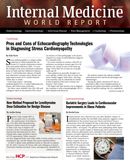Publication
Article
Internal Medicine World Report
β-lactam, Macrolide or Both? Treating Community-Acquired Pneumonia
Author(s):
A non-inferiority study published in the October 6, 2014 issue of JAMA Internal Medicine looks at these drugs. The researchers report that prescribing β-lactam monotherapy may be as effective as the combination of a macrolide with a β-lactam in certain patients.

Community-acquired pneumonia presents a number of dilemmas. Patients may be elderly or frail and it’s sometimes difficult to identify the infectious organism initially. There is considerable debate about the selection of an appropriate antibiotic or antibiotics. Most experts recommend a β-lactam for hospitalized patients; it covers typical infectious agents. Many patients need coverage for atypical pathogens (eg, Legionella species, Mycoplasma pneumoniae, and Chlamydia pneumoniae). Is a macrolide or a fluoroquinolone better add-on treatment?
A non-inferiority study published in the October 6, 2014 issue of JAMA Internal Medicine looks at these drugs. The researchers report that prescribing β-lactam monotherapy may be as effective as the combination of a macrolide with a β-lactam in certain patients.
This open-label, multicenter, noninferiority, randomized trial study looked at 580 immunocompetent adult patients hospitalized for moderately severe community-acquired pneumonia at 6 acute care hospitals. The study was conducted over 4 years. The researchers randomized patient to either with a β-lactam and a macrolide (combination arm) or with a β-lactam alone (monotherapy arm).
At one week, 41% of patients receiving monotherapy were clinically stable. In the combination arm, 34% of patients reached clinical stability. Patients infected with typical pathogens or less severe Pneumonia Severity Index (PSI) categories had similar results regardless of treatment received.
Patients infected with atypical pathogens or with PSI category IV pneumonia were less likely to reach clinical stability with monotherapy. The researchers tested for Legionella using urinary antigen testing, and even in patients who tested positive and were treated appropriately, clinical stability was delayed.
Patients treated with monotherapy were more likely to be re-admitted with 30 days than those with combination coverage. All other measure of successful infection eradication were monitored for 90 days and similar in the 2 arms.
The researchers report 2 clinical implications. First, initial empirical treatment with β-lactam monotherapy is not indicated in patients infected with atypical pathogens. They speculate that faster introduction of a macrolide in patients with a positive Legionella test may result in better outcomes is hypothetical. Second, combination therapy seems to produce better outcomes in patients with more severe pneumonia.






